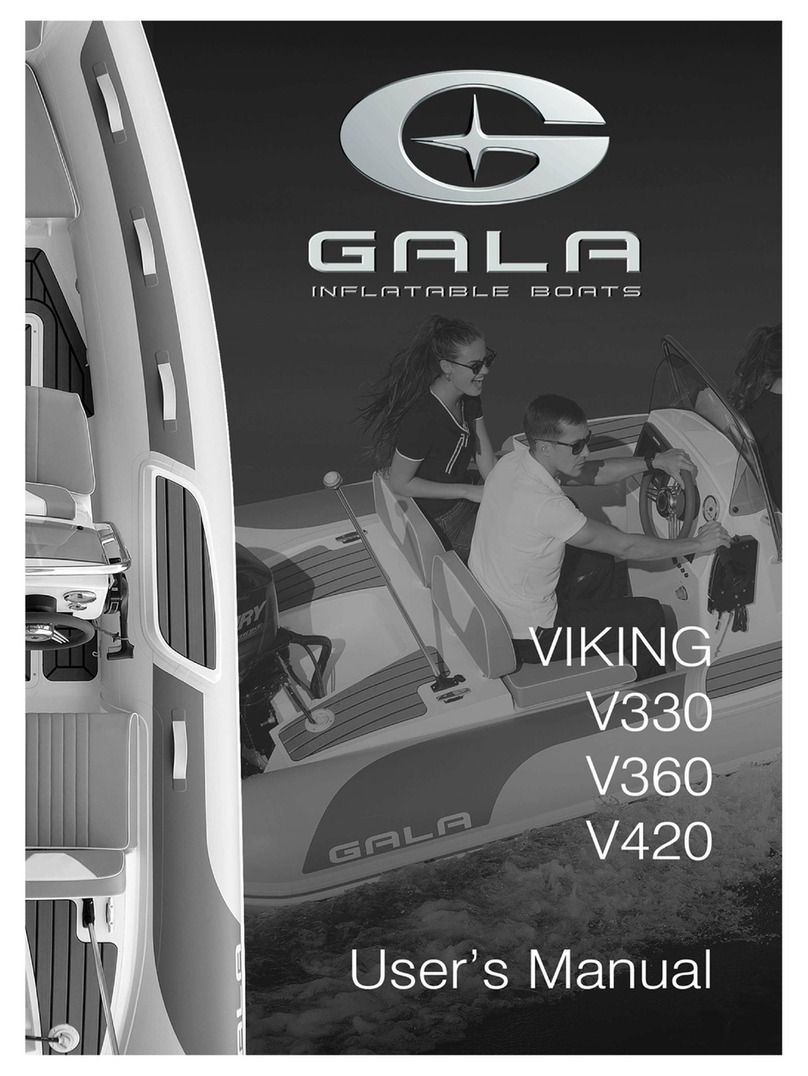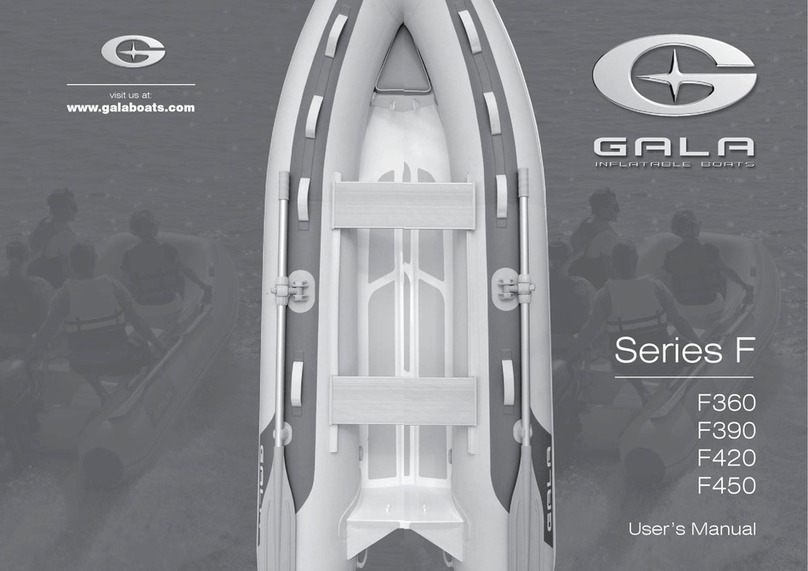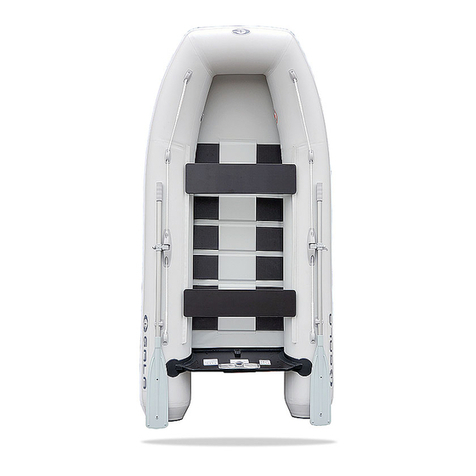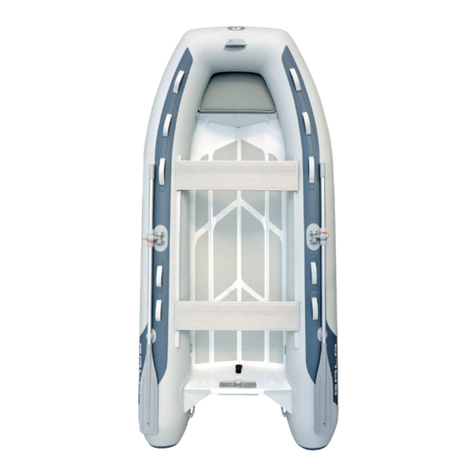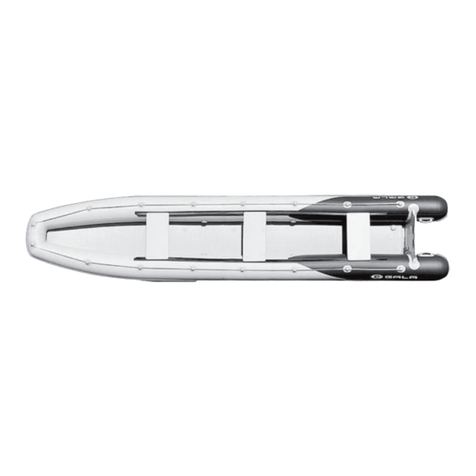
DANGER
1. WEAR PERSONAL FLOTATION DEVICE (PFD)
2. ALWAYS USE THE STOP SWITCH LANYARD: wear it
around your wrist or affix to your clothes.
3. NO ALCOHOL / DRUGS BEFORE OR WHILE
OPERATING YOUR BOAT.
4. DO NOT EXCEED THE AUTHORIZED NUMBER OF
PERSONS OR WEIGHT.
5. MAKE SURE YOUR PASSENGERS REMAIN
SEATED ON SEATS OR ON THE FLOOR. AVOID
SEATING ON TUBES.
6. NO BOW RIDING AS IT IS ILLEGAL AND
EXTREMELY DANGEROUS.
7. BE ESPECIALLY CAREFUL WHEN DOCKING: Arms
and legs may be injured if they are outside the boat.
8. KEEP CLEAR OF SWIMMERS AND DIVERS: Always
avoid areas where divers/swimmers are in the water.
Keep a sharp lookout especially when operating near
beaches and launch sites. Shut off the motor when
operating near someone in the water. The Alpha flag
indicates proximity of divers. You MUST stay at a good
distance (minimum 50 meters).
9. AVOID SHARP TURNS AT HIGH SPEEDS: You could
get ejected from the boat.
10. DO NOT make a brutal change in direction without
advising passengers.
11. NO SPEEDING OR RACING! Driver must keep
reasonable speed to avoid any boat stability loss.
12. BATTERY:
a. Avoid sparks and open flames near battery. It
may explode.
b. Keep battery poles protected from any
shortcut or contact with any metal things.
c. Turn off the engine when inspecting or
servicing the battery.
d. Never keep battery close to fuel tank, filler or
fuel system elements.
13. AVOID any contact of the inflatable tube with any sharp
objects or aggressive liquids or chemicals.
14. INSPECT AND MAINTAIN STEERING SYSTEM: an
improperly maintained system may fail, causing
sudden loss of control.
c) Rules to observe during navigation:
• Be responsible: do not neglect the safety rules.
• Learn to always keep control of your boat.
• Always operate with courtesy and respect.
• Respect local regulations and practices.
• Near the shore, navigate in the designated boating areas.
• Always be sure that you can reach a shelter rapidly.
15. AVOID THE RISKS OF EXPLOSION OR FIRE
HAZARDS : Ensure your fuel system is in a good
with no leaks or smell, and maintain it properly.
16. AVOID SMOKING ON BOARD.
17. IF FUEL HAS SPILLED ON THE FLOOR: wash off
with water. Stop operating the boat if you discover any
fuel leak or fuel smell until you find and fix the problem.
CAUTION
1. Towing must be done at low speed (not more then 10
km/h) and in good weather conditions with no waves.
2. Towing boat must be supervised at all time of towing.
e) Lifting the boat:
To lift boat and place it on davits, use the factory installed lifting eyes only, or
have them installed by your Dealer if the boat is not equipped. Use only
certified and rated lifting slings, appropriate for your boat and motor weight.
WARNING
1. NOBODY ON BOARD WHEN LIFTING.
2. WHEN LIFTED, THE BOAT MUST BE EMPTY (NO
EQUIPMENT) AND TIPPED TOWARD THE REAR
WITH OPEN BAILERS.
- 16 - - 17 -
d) Mooring and Towing:
•
MOORING: Use the bow and rear cleats. When moored, the self bailers
should remain open to drain the rain water
•
TOWING: For proper and safe towing ask your Dealer for installation of the
towing eyes. You can also use the bow eye on a hull for short distance
towing at low speed with no waves.
f) Trailer and davits system use:
• The trailers size and carrying capacity should correspond to your boat size and
weight. Do not use too big or too small trailer for your boat.
• Always prefer trailer / davits system with bolsters / banks with large contact spot to
rollers. Do not use the trailers / davits system with rollers only.
• The boat must be properly inflated. Leave the self-bailer open.
• Haul the boat onto the trailer using the bow eye.
• Lift the engine shaft down and fix it to the support provided on a trailer. Do not trailer
or store the boat on davits without proper engine support on the trailer.
• Tie down the boat with straps, using bow, lateral and rear eyes for that.
• Close and secure all hatches and doors on the boat. Cushions must be secured or
taken away to prevent the loss.
• Do not trailer the boat with the cover, which is not designed for transportation.
•
Manufacturer does not cover any damage caused by trailering of lifting system.
Ask for professional advice of authorized Dealer to choose the right trailer or lifting
system to avoid any damage or injury.








